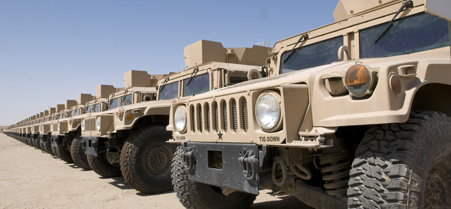Small system at the center of big move from Iraq to Afghanistan
The Third Army's Logistical Theater Common Operating Picture consists of three servers and a staff of four to track and deliver nearly 3 million pieces of equipment.
 Many of the 2.8 million pieces of equipment are held in Kuwait and on the way to Afganistan.
Many of the 2.8 million pieces of equipment are held in Kuwait and on the way to Afganistan.
The Army has mounted its largest logistical operation since World War II as it moves some 2.8 million pieces of equipment out of Iraq to Afghanistan and stateside bases, a top commander said during a press briefing on Friday.
The gear moving out of Iraq includes 88,000 shipping containers packed with equipment and 41,000 tracked and wheeled vehicles, said Lt. Gen. William Webster, commander of the Third Army who spoke from his headquarters in Kuwait. The logistics operation is called Nickel II, under which the Army will transport much of the equipment over routes that in some cases stretch 5,000 miles to destinations in Afghanistan.
To inventory and manage the massive amounts of gear, the Third Army originally used an equally mammoth Excel spreadsheet it called the Big Kahuna, which grew to 15 megabytes, Maj. Chris Heath, Third Army logistics automation officer, told Nextgov in a phone interview from Kuwait.
The database became bloated because it included not only major pieces of equipment, such as mine resistant-ambush-protected vehicles, but also subcomponents and repair parts. Today, the Third Army tracks more than 1.2 billion items that must be shipped to home bases or Afghanistan, he said.
The spreadsheet is populated with data drawn from multiple, stovepiped logistics information systems such as the Standard Army Maintenance System and the Unit Level Logistics System. It became too unwieldy to manage the drawdown and subsequent transfer of equipment from Iraq, and the Third Army logistics operations section started to look for ways to process the information in November 2008.
Heath said the new application would require more than just a database; it had to analyze all the information because when one piece of equipment is moved, such as an MRAP, it can have an effect on Army units in the entire Central Command. It's like pulling out one stick in a game of pickup sticks, which has an effect on the entire pile, he explained.
Getting usable information from the systems that populated the Big Kahuna spreadsheet took weeks, and the Third Army needed logistics data in as near real time as possible. Heath, working with Julian Lugo, a support contractor, said the Third Army found the answer by using a business intelligence suite from Oracle that provided the service with tools to analyze one of the largest logistics operations in history.
The Logistical Theater Common Operating Picture "helps make timing decisions when to pull [a piece of equipment] and where to place it," Heath said.
"When dealing with feeds from the standalone standard Army information systems, the business intelligence software establishes rules on how to join together disparate data elements," Lugo said.
The elements include real-time feeds from active radiofrequency identification tags attached to containers and vehicles, which track shipments as they traverse a 1,200 mile land route through Pakistan or a 5,000 mile route on the Northern Distribution Network through Europe and East Asia.
The tags allow the Third Army to see the location of equipment almost on a real-time basis as it moves from the area of operations in Iraq to Afghanistan, according to Heath.
The Third Army has spent $4 million to build the Common Operating Picture system, which includes a minimal amount of hardware: three servers and a staff of four. Other Defense organizations might use the system, including the Central, Pacific and European commands.
NEXT STORY: Big Payback For VA Health IT



